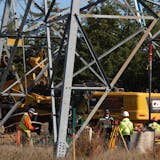UNDERWOOD, N.D. – The chimneys of Coal Creek Station, North Dakota's largest power plant, tower 60 stories over the prairie. Nearby, an excavator that looks like a giant crane looms over a big coal mine.
The mine feeds the plant owned by Maple Grove-based Great River Energy, which churns out electricity for hundreds of thousands of Minnesotans. Four other coal mines dot the North Dakota countryside, mostly supplying neighboring power plants.
This "mine-to-mouth" model produces some of the cheapest power in the country and has enabled coal to remain an economic anchor in North Dakota, even as the industry crumbles in other parts of the United States.
Mines have actually been hiring in North Dakota in recent years, a sharp contrast to other coal regions. Utilities have been investing significant money in coal-powered plants.
"The coal industry has rolled back considerably from what it was 10 to 20 years ago, but we haven't seen that in North Dakota," said Dean Bangsund, an economist at North Dakota State University.
Still, the forces causing electricity producers to forsake coal nationally are creeping into the landscape. Wind power is surging, and it can be even cheaper than electricity produced from North Dakota's coal-fired plants.
Great River has responded by retooling its Coal Creek plant so production can be more easily reduced when it's windy. Other plants are doing the same, or looking at it. But the more they reduce production, the less coal they need — what could be a troubling prospect for the coal mines in the long-term future.
The state's coal industry "isn't immune to what's occurring in the rest of the U.S., but it may be the last place where it hits," Bangsund said.


